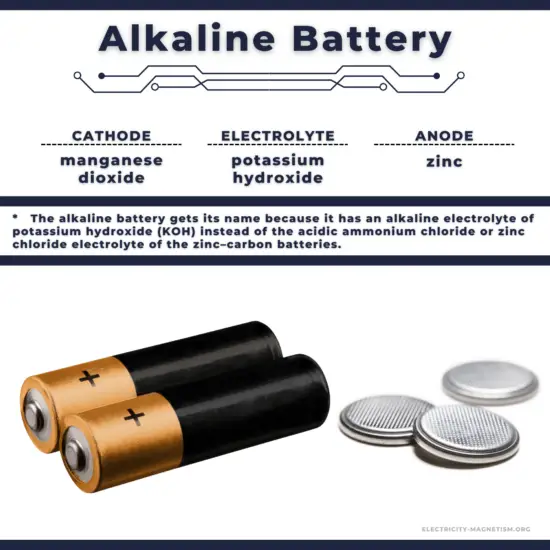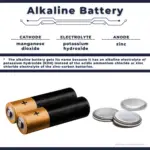30-second summary
Composition of Alkaline Battery
The alkaline battery consists of five parts:
- Inner current collector (pin)
- Anode. The active material in the anode is Zn. With a standard electrode potential (SEP) of −0.76 volts, zinc is used as an anode material for batteries. (More reactive lithium (SEP −3.04 V) is used for anodes in lithium batteries ).
- Separator. A separator is a permeable membrane placed between a battery’s anode and cathode. For example, non-woven, fibrous fabric that separates the electrodes.
- Cathode. The active material of the cathode is manganese dioxide. The principal use for MnO2 is for dry-cell batteries, such as the alkaline battery and the zinc-carbon battery.
- Electrolyte. Aqueous potassium hydroxide is employed as the electrolyte in alkaline batteries.
- Outer current collector (can)

Alkaline Battery
An alkaline battery (IEC code: L) is a type of primary battery that provides direct electric current from the electrochemical reaction between zinc and manganese dioxide (MnO2) in the presence of an alkaline electrolyte.
The alkaline battery gets its name because it has an alkaline electrolyte of potassium hydroxide (KOH) instead of the acidic ammonium chloride (NH4Cl) or zinc chloride (ZnCl2) electrolyte of the zinc–carbon batteries. Other battery systems also use alkaline electrolytes, but they use different active materials for the electrodes.
The primary alkaline battery is a widely used product, which is essential for powering many portable devices, such as power tools, radios, toys, and remote controls. The most common size of alkaline battery is the well-known AA battery. Alkaline batteries are most commonly used in portable devices that have low current drains, are used only intermittently, or are used well away from an alternative power source, such as in alarm and communication circuits where other electric power is only intermittently available.
Composition of Alkaline Battery
The alkaline battery consists of five parts:
- Inner current collector (pin)
- Anode. The active material in the anode is Zn. With a standard electrode potential (SEP) of −0.76 volts, zinc is used as an anode material for batteries. (More reactive lithium (SEP −3.04 V) is used for anodes in lithium batteries ).
- Separator. A separator is a permeable membrane placed between a battery’s anode and cathode. For example, non-woven, fibrous fabric that separates the electrodes.
- Cathode. The active material of the cathode is manganese dioxide. The principal use for MnO2 is for dry-cell batteries, such as the alkaline battery and the zinc-carbon battery.
- Electrolyte. Aqueous potassium hydroxide is employed as the electrolyte in alkaline batteries.
- Outer current collector (can)
As shown in the figure, the porous anode and cathode make up the largest parts of the battery. Both electrodes are made of particles, with electrolyte filling the void areas of the electrode. The electric power of the Zn-MnO2 battery comes from the electrochemical reactions of the cathode and anode active materials. A porous separator keeps the cathode and anode from touching each other. The function of the two current collectors is to build a connection between the battery and the outer electrical circuit.



